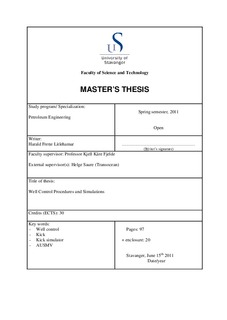| dc.contributor.author | Litlehamar, Harald | |
| dc.date.accessioned | 2011-10-28T12:53:15Z | |
| dc.date.available | 2011-10-28T12:53:15Z | |
| dc.date.issued | 2011 | |
| dc.identifier.uri | http://hdl.handle.net/11250/183355 | |
| dc.description | Master's thesis in Petroleum engineering | no_NO |
| dc.description.abstract | A brief introduction is given to a range of well control procedures. It was found that many of the procedures rely on a set of simplifying assumptions. This is particularly true in the hand calculations for designing a well kill. This set of assumptions was used to define an analytical model. The premises of the analytical model and some of the procedures were tested in a crude kick simulator. The main objective of this thesis was to verify some of the well control procedures, and to shed light on their limitations. Particular attention was given to driller’s method for a vertical and horizontal well. Additionally, simulations were run to investigate the worst case scenarios which a well might be subjected to if well control is lost.
As a means for achieving this, the previously implemented explicit numerical AUSMV scheme was used as a basis for simulations on a kicking well. However, in order to conduct realistic simulations some modifications to the scheme had to be introduced. The most important modification was the implementation of a PI-regulator, as it proved impossible simply to set the bottomhole pressure to a defined constant value in the numerical scheme. Extensive tuning of the regulator was necessary for it to perform satisfactory. In this process, a novel alternative to the classical PI-regulator was discovered.
Further modifications deemed necessary:
• Improved accuracy in reading of bottomhole and choke pressures.
• Implementation of additional topside parameters (pit gain, drillpipe pressure)
• A more realistic friction model.
• Changing the liquid component of the system from water to drilling fluid (altering the liquid density).
• A chokeline and riser for simulation on subsea wells.
• Opening up for wellbore deviation.
• A Darcy relation for influx where influx size and mass rate depends on downhole pressure differential. This is important for drilled kicks or connection kicks.
• Additionally, a choke model was implemented in the model, but it has not been used in the simulations. The choke model depicts the backpressure as a function of fluid density, flow rate and choke opening.
By use of the crude kick simulator, simulations were run for a vertical and a horizontal well. The results obtained by the kick simulator were compared to hand calculations. The main discovery was that although the hand calculations produce slight errors, the errors exclusively functions as additional safety margins with respect to downhole pressure differential.
It was also found that a gas bubble migrating in a shut-in annulus subjects the well to higher loads than the gas filled well scenario. | no_NO |
| dc.publisher | University of Stavanger, Norway | no_NO |
| dc.relation.ispartofseries | Masteroppgave/UIS-TN-IPT/2011; | |
| dc.subject | petroleumsteknologi | no_NO |
| dc.subject | boreteknologi | no_NO |
| dc.subject | well control | no_NO |
| dc.subject | kick | no_NO |
| dc.subject | kick simulator | no_NO |
| dc.subject | AUSMV | no_NO |
| dc.title | Well control procedures and simulations | no_NO |
| dc.type | Master thesis | no_NO |
| dc.subject.nsi | VDP::Technology: 500::Rock and petroleum disciplines: 510::Petroleum engineering: 512 | no_NO |
